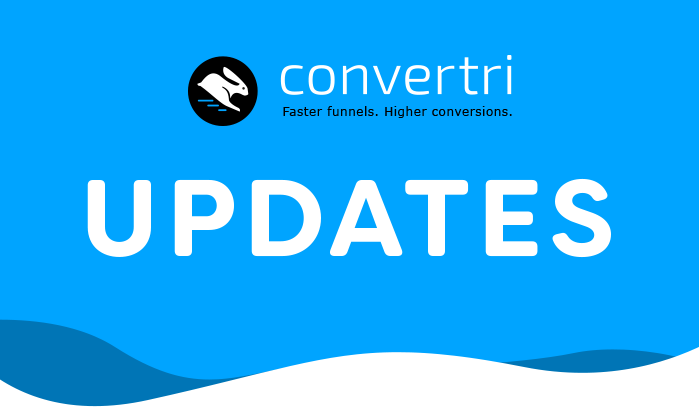What is Conversion Rate Optimisation?
Conversion rate optimisation turns clicks into customers. Learn proven strategies to increase revenue from your existing website traffic.
Conversion rate optimisation (or CRO) is the practice of converting more leads into customers. Optimising your conversion rate can include tweaking your copy, making changes to your page design, or changing any number of other factors, such as your offer or times you post on social media, with one goal in mind – getting more conversions.
By optimising your conversion rate, you’re maximising the revenue you get for every visitor to your page. But let’s start at the beginning—what do we mean when we talk about conversion rates?
Key Takeaways:
- Maximize traffic value. CRO helps you get more sales from the visitors you already have.
- Test for success. Use testing to learn what works best for your audience.
- Small tweaks matter. Simple changes can create big improvements in conversions.
Every visitor counts. Convert more of them with a funnel built for maximum performance.
What Is a Conversion Rate?
Conversion rate simply means the number of visitors to your site that complete a desired action and goal (i.e., a conversion) out of the total number of visitors.
For instance, let’s say you have a 25% percent conversion rate. That means only 25% of the people who visit your website convert.
Imagine your website as a brick-and-mortar store. If you get 100 people through the door, many of them might browse and look around, but only 25 will leave with a purchase. That’s your conversion rate.
Understanding Conversion Rate Optimisation (CRO)
Everybody wants a high conversion rate. A high conversion rate means your web design and marketing efforts are successful: you’ve made people want your offer and made it easy for them to get it!
Some examples of conversions include:
- E-commerce: Add-to-cart, completed checkouts
- Lead Generation: Contact forms, demo requests
- Content Marketing: Newsletter signups, downloads
- SaaS: Free trials, account upgrades
As for what average conversion rate you should be aiming for, or what’s a “good” conversion rate, you might as well ask “how long is a piece of string”. The answer will vary by industry, product, niche, and a host of other factors. Also, if your conversion rate was particularly low to begin with, an improvement by 0.1% could be considered “good” by comparison.
Generally speaking, you should always aim to increase your conversion rate. And you can do that with conversion rate optimization (CRO) techniques.
Elevate your CRO to the next level. Start optimizing your funnel with Convertri today.
Why Is CRO Important?
Increase Value from Existing Traffic
Driving new traffic is costly. CRO helps you maximize leads generated and sales from people already visiting your site.
Boost Revenue Without Extra Ad Spend
CRO lets you squeeze more value from your existing traffic. Improve your site’s conversion rate without raising ad budgets.
Lower Customer Acquisition Costs
When you convert more visitors into buyers, your cost per acquisition drops. This makes your campaigns more efficient.
How Does CRO Work?
When it comes to increasing conversions, it’s kind of like navigating stormy seas. No path is going to be the same: some people will have bigger boats or more satellite navigation equipment and still fail, others will just get lucky. Sometimes your goal is out of reach no matter what, and other times the conditions are more favourable.
Here’s how it works:
Understand User Behavior
Through user research, you uncover how people engage with your web pages. Heatmaps, scroll maps, and user feedback reveal where users get stuck.
Analyze Website Data
There’s one way to improve your sales without impacting your conversion rate: increasing traffic. By playing the numbers game, you’re getting more people through your proverbial doors, without affecting your conversion rate.
Using the bricks and mortar example above, it would be like attracting 200 customers into your store, doubling your potential customers. Even if your conversion rate stays at 25%, it’s now 25% of 200, not 100. Fifty sales are better than twenty five – but as far as effort goes, it’s much more efficient to coax purchases out of the traffic you already have, instead of getting more visitors.
Tools like Google Analytics track traffic, bounce rates, and conversion metrics. These key metrics show where people drop off and where improvements are needed.
Test and Experiment (A/B & Multivariate Testing)
CRO thrives on testing. Split testing (A/B testing) compares two versions of a page or call to action, while multivariate testing experiments with multiple elements to see which combination performs best.
Implement Proven Changes
Once you identify what works—whether it’s a shorter form, stronger headline, or improved layout—you roll out the winning version permanently to increase conversions.
Key Aspects of Conversion Rate Optimisation

Landing Page Optimization
Your landing page should have a clear headline, benefit-driven copy, strong visuals, and a persuasive call to action.
But like sailing, there are some general principles you should keep at hand, and know when to use them for maximum effect. For example, one study found that using long-form landing pages increased conversions by 220 percent. Neat, huh? Not when you consider that some companies find that short-form landing pages work better for their offer and their audiences.
Website Navigation Improvements
Simplified menus and mobile-friendly layouts keep user engagement high. Confusing navigation can hurt your website’s conversion rate.
Checkout Process Streamlining
Cart abandonment is common. Streamlined checkout processes—clear steps, multiple payment options, and mobile optimization—help convert visitors into customers.
Stronger Calls to Action
A CTA should be bold, visible, and persuasive. Testing button copy, color, and placement can make a huge difference.
Personalization and Targeting
Customizing offers for your target audience makes your optimization strategy more relevant and increases conversion likelihood.
Common CRO methods
In the world of digital marketing, CRO best practices have a few tried-and-tested methods that are generally considered to help raise conversion rates across the board.
Many of these methods are ones we talk about in this blog. They are:
- Use a strong CTA (call-to-action)
- Bold colours attract attention to the CTA
- Place CTAs above the fold
- Use urgency to drive sales
- Display testimonials and social proof
- Use fewer form fields on your forms
If you’re just starting out with optimisation? Try these first. They’re kind of like the “golden rules”, which, when they’re missing, are the most common weak spots in any landing page.
Just like whenever you make changes to your page, test, test, and test again. Split testing will likely lead to a bump in conversions when you hit upon something that benefited from optimisation, and you can follow that thread to make similar improvements elsewhere.
But what about when the above methods don’t work for you?
Don’t leave conversions to chance. Use a funnel builder designed to turn every click into a customer.
Intelligent CRO: Know Your Audience
Just because it worked for someone else doesn’t mean it’s going to work for you.
That’s true, even with the golden rules above. Maybe your audience loves filling out long, complex forms. Perhaps they don’t trust social proof, even from good sources, or aren’t moved by urgent, limited-time offers.
Those examples are a bit silly. In truth, while those golden rules take care of what the broad populace wants on a landing page, they won’t speak to your core visitors on a deep enough level. The very best CRO methods will be found when you deep dive into what your audience really wants and needs.
Take form fields, for example. The fewer the better, right?
In most cases – but not all.
When Unbounce analysed its own landing page, it got a bit of a surprise. For years, they had been advocating the “less is more” approach to form fields, which was originally touted by Imaginary Landscape back in 2008 (yes, the theory is that old). But look what was happening on their landing page:

Conversion rates were highest with only one form field. And also decreased with each additional form field. But… things start to climb again after seven form fields. What the heck is going on?
In their aggressive pursuit of fewer form fields, Unbounce were forgetting that sometimes, website visitors want to fill out longer forms. They want to volunteer more information.
To understand why, let’s look at another example.
Back in 2018, we dived into a case study of Brandwatch, which used a circular funnel to get conversions. Take a look at their opt-in page:

That’s not a tiny form. To grab a copy of a free lead magnet, you usually just need to put in your email – but this form has five fields, plus a checkbox. But Brandwatch has tailored this form to their audience: business people. Email is clearly defined as a “work” address – and when I initially entered my personal Outlook, it popped up with a message that said “Please enter your work email.”
Yes, it’s been designed to reject anything that looks like a personal email.
Also, the fields Company and Job Title might seem unnecessary, but by putting them there, Brandwatch is communicating that they want enquiries from real businesses that they can chase up later. This form is a substantial commitment to fill out. All of this communicates one message: serious folks only, please.
All of this is carefully designed to not only increase Brandwatch’s conversion rate, but also attract a more desirable kind of customer for their offer, who are more likely to give more value to the company over time.
How To Optimise Your Own Conversion Rate
So, what does this mean for your sales page? If the best kind of CRO is highly individual, where do you start?
If you’re only testing CRO techniques like the ones above – form fields, CTA’s, page design – then go ahead and follow your heart.
But when you’re out of ideas, it’s time to do some research.
1. Quantitative research helps you understand “what”
Firstly, track as much data on your website as possible about what’s already happening. Try:
- Analytics tools like Google Analytics that track website traffic
- Heat map tools compile and track user interactions on a webpage, including scrolls, clicks, and mouse movements.
- Tracking form submissions
2. Qualitative research helps you understand “why”
Next, look at collecting non-numerical data to learn why your visitors behave in a certain way. Try:
- Website feedback tools, such as on-page and external link surveys
- Website session recording or replay tools that show how individual users navigate through your website
- Customer feedback benefits your website by allowing customers to share their thoughts.
- Online reviews offer insights into customer experiences with your brand and product.
3. A/B testing helps you understand “how”
Next, you just need to test changes and measure improvements – and you do this by split testing. This enables you to implement changes and assess the effectiveness of your conversion optimization efforts.
Any reputable funnel builder will include split testing capability – we do here at Convertri. It’s the best way to see what’s working and even track what’s not.
Final Thoughts
The conversion rate optimization process isn’t about following generic tips. It’s also about understanding your target audience, analyzing conversion metrics, running a CRO test, and applying changes based on results.
Even small tweaks—like refining your call to action, improving mobile usability, or adding customer testimonials—can create massive improvements in your website’s conversion rate.
At Convertri, our funnel builder comes with built-in optimization tools. These tools make it easier to boost conversions without guesswork.
Got any CRO stories you’d like to share? How have you found success optimising conversions on your landing or sales pages? Leave them in the comments below!





